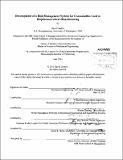| dc.contributor.advisor | Josef Oehmen and Roy Welsch. | en_US |
| dc.contributor.author | Linders, David (David Robert) | en_US |
| dc.contributor.other | Leaders for Global Operations Program. | en_US |
| dc.date.accessioned | 2013-10-24T17:48:37Z | |
| dc.date.available | 2013-10-24T17:48:37Z | |
| dc.date.copyright | 2013 | en_US |
| dc.date.issued | 2013 | en_US |
| dc.identifier.uri | http://hdl.handle.net/1721.1/81723 | |
| dc.description | Thesis (S.M.)--Massachusetts Institute of Technology, Dept. of Mechanical Engineering; and, (M.B.A.)--Massachusetts Institute of Technology, Sloan School of Management; in conjunction with the Leaders for Global Operations Program at MIT, 2013. | en_US |
| dc.description | Cataloged from PDF version of thesis. | en_US |
| dc.description | Includes bibliographical references (p. 116-117). | en_US |
| dc.description.abstract | Injectable drugs, like those manufactured by the BioPharmOps group of Novartis Pharmaceuticals AG, must conform to strict guidelines for purity and potency. Recent non-conformances of critical supplied consumables have revealed potential business and patient safety risks for biotechnology manufacturers worldwide. As a result, Novartis has launched a program to enhance control systems over all consumables and their suppliers. Within this program, the author has developed a system to identify, analyze, and mitigate the various risks which may impact the business due to non-conformances in supplied consumables. The first function of the system is the identification of key risks and their potential effects according to various failure modes that have been observed during the use of the consumables in production. This is accomplished with a standardized list of possible failure modes which can be applied to all consumables. The categorization allows the relative risk of each failure mode to be compared among consumables. Secondly, the risk of contamination is evaluated using a Failure Modes and Effects Analysis (FMEA) framework. The three dimensions of the FMEA framework are the severity, likelihood, and detectability of a failure. The severity of each failure mode is assessed by analyzing the quantitative and qualitative impact that a failure might have on the purity and potency of the drug. This calculation is based on the properties of each consumable and its use in the production system. The likelihood of failure events is assessed through an analysis of the complexity of the consumable and its supply chain, and a review of the quality systems at the supplier. Detectability analysis considers the tests and inspections in place at various stages including consumable manufacturing, receiving inspection, and in-process tests during drug manufacturing which could detect a non-conformance. The total risk level is evaluated as the product of these three dimensions and a threshold is defined for requiring additional mitigations for these risks. This risk assessment method is implemented in an automated worksheet to ensure consistency among users and efficient analysis. The third outcome of the system is the recommendation of mitigations to reduce total exposure to contamination risk. Mitigations may be internal (new tests and inspections) or implemented at the supplier (improved sampling rates, enhanced general quality systems, or new controls). The recommended mitigations provide guidance for the reduction of risks to an acceptable level, and when implemented, the impact and frequency of non-conformances will be diminished. Ultimately, this reduces Novartis' exposure to potential business loss and protects patients from injury caused by contamination. | en_US |
| dc.description.statementofresponsibility | by David Linders. | en_US |
| dc.format.extent | 139 p. | en_US |
| dc.language.iso | eng | en_US |
| dc.publisher | Massachusetts Institute of Technology | en_US |
| dc.rights | M.I.T. theses are protected by
copyright. They may be viewed from this source for any purpose, but
reproduction or distribution in any format is prohibited without written
permission. See provided URL for inquiries about permission. | en_US |
| dc.rights.uri | http://dspace.mit.edu/handle/1721.1/7582 | en_US |
| dc.subject | Mechanical Engineering. | en_US |
| dc.subject | Sloan School of Management. | en_US |
| dc.subject | Leaders for Global Operations Program. | en_US |
| dc.title | Development of a risk management system for consumables used in biopharmaceutical manufacturing | en_US |
| dc.type | Thesis | en_US |
| dc.description.degree | M.B.A. | en_US |
| dc.description.degree | S.M. | en_US |
| dc.contributor.department | Leaders for Global Operations Program at MIT | en_US |
| dc.contributor.department | Massachusetts Institute of Technology. Department of Mechanical Engineering | |
| dc.contributor.department | Sloan School of Management | |
| dc.identifier.oclc | 861186078 | en_US |
